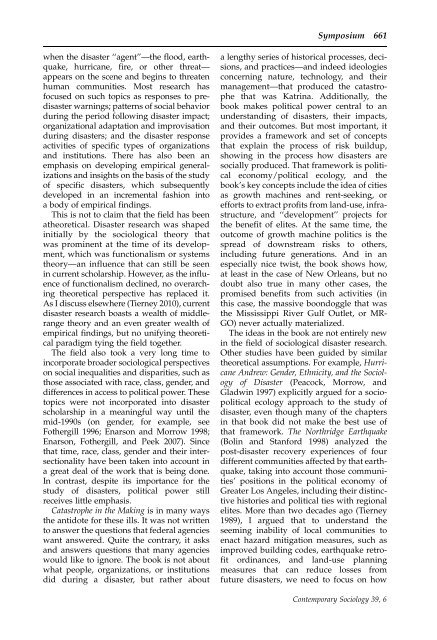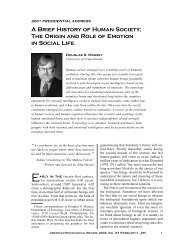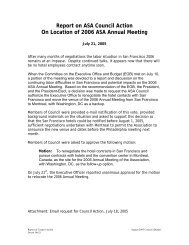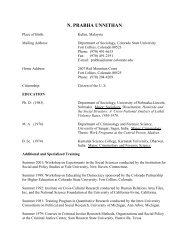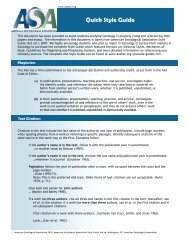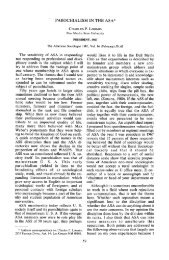Contemporary Sociology - American Sociological Association
Contemporary Sociology - American Sociological Association
Contemporary Sociology - American Sociological Association
Create successful ePaper yourself
Turn your PDF publications into a flip-book with our unique Google optimized e-Paper software.
when the disaster ‘‘agent’’—the flood, earthquake,<br />
hurricane, fire, or other threat—<br />
appears on the scene and begins to threaten<br />
human communities. Most research has<br />
focused on such topics as responses to predisaster<br />
warnings; patterns of social behavior<br />
during the period following disaster impact;<br />
organizational adaptation and improvisation<br />
during disasters; and the disaster response<br />
activities of specific types of organizations<br />
and institutions. There has also been an<br />
emphasis on developing empirical generalizations<br />
and insights on the basis of the study<br />
of specific disasters, which subsequently<br />
developed in an incremental fashion into<br />
a body of empirical findings.<br />
This is not to claim that the field has been<br />
atheoretical. Disaster research was shaped<br />
initially by the sociological theory that<br />
was prominent at the time of its development,<br />
which was functionalism or systems<br />
theory—an influence that can still be seen<br />
in current scholarship. However, as the influence<br />
of functionalism declined, no overarching<br />
theoretical perspective has replaced it.<br />
As I discuss elsewhere (Tierney 2010), current<br />
disaster research boasts a wealth of middlerange<br />
theory and an even greater wealth of<br />
empirical findings, but no unifying theoretical<br />
paradigm tying the field together.<br />
The field also took a very long time to<br />
incorporate broader sociological perspectives<br />
on social inequalities and disparities, such as<br />
those associated with race, class, gender, and<br />
differences in access to political power. These<br />
topics were not incorporated into disaster<br />
scholarship in a meaningful way until the<br />
mid-1990s (on gender, for example, see<br />
Fothergill 1996; Enarson and Morrow 1998;<br />
Enarson, Fothergill, and Peek 2007). Since<br />
that time, race, class, gender and their intersectionality<br />
have been taken into account in<br />
a great deal of the work that is being done.<br />
In contrast, despite its importance for the<br />
study of disasters, political power still<br />
receives little emphasis.<br />
Catastrophe in the Making is in many ways<br />
the antidote for these ills. It was not written<br />
to answer the questions that federal agencies<br />
want answered. Quite the contrary, it asks<br />
and answers questions that many agencies<br />
would like to ignore. The book is not about<br />
what people, organizations, or institutions<br />
did during a disaster, but rather about<br />
Symposium 661<br />
a lengthy series of historical processes, decisions,<br />
and practices—and indeed ideologies<br />
concerning nature, technology, and their<br />
management—that produced the catastrophe<br />
that was Katrina. Additionally, the<br />
book makes political power central to an<br />
understanding of disasters, their impacts,<br />
and their outcomes. But most important, it<br />
provides a framework and set of concepts<br />
that explain the process of risk buildup,<br />
showing in the process how disasters are<br />
socially produced. That framework is political<br />
economy/political ecology, and the<br />
book’s key concepts include the idea of cities<br />
as growth machines and rent-seeking, or<br />
efforts to extract profits from land-use, infrastructure,<br />
and ‘‘development’’ projects for<br />
the benefit of elites. At the same time, the<br />
outcome of growth machine politics is the<br />
spread of downstream risks to others,<br />
including future generations. And in an<br />
especially nice twist, the book shows how,<br />
at least in the case of New Orleans, but no<br />
doubt also true in many other cases, the<br />
promised benefits from such activities (in<br />
this case, the massive boondoggle that was<br />
the Mississippi River Gulf Outlet, or MR-<br />
GO) never actually materialized.<br />
The ideas in the book are not entirely new<br />
in the field of sociological disaster research.<br />
Other studies have been guided by similar<br />
theoretical assumptions. For example, Hurricane<br />
Andrew: Gender, Ethnicity, and the <strong>Sociology</strong><br />
of Disaster (Peacock, Morrow, and<br />
Gladwin 1997) explicitly argued for a sociopolitical<br />
ecology approach to the study of<br />
disaster, even though many of the chapters<br />
in that book did not make the best use of<br />
that framework. The Northridge Earthquake<br />
(Bolin and Stanford 1998) analyzed the<br />
post-disaster recovery experiences of four<br />
different communities affected by that earthquake,<br />
taking into account those communities’<br />
positions in the political economy of<br />
Greater Los Angeles, including their distinctive<br />
histories and political ties with regional<br />
elites. More than two decades ago (Tierney<br />
1989), I argued that to understand the<br />
seeming inability of local communities to<br />
enact hazard mitigation measures, such as<br />
improved building codes, earthquake retrofit<br />
ordinances, and land-use planning<br />
measures that can reduce losses from<br />
future disasters, we need to focus on how<br />
<strong>Contemporary</strong> <strong>Sociology</strong> 39, 6


